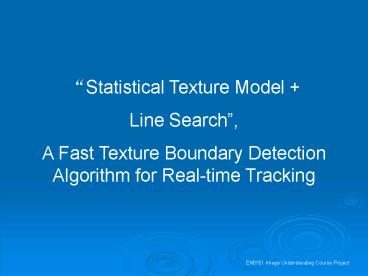EN0161 Image Understanding Course Project - PowerPoint PPT Presentation
1 / 33
Title:
EN0161 Image Understanding Course Project
Description:
Debug the algorithm in lightly textured environment first. ... Supposedly, probability model based algorithms are able to work with Dynamic ... – PowerPoint PPT presentation
Number of Views:71
Avg rating:3.0/5.0
Title: EN0161 Image Understanding Course Project
1
Statistical Texture Model Line Search, A
Fast Texture Boundary Detection Algorithm for
Real-time Tracking
EN0161 Image Understanding Course Project
2
Statistical Texture Model Line Search, A Fast
Texture Boundary Detection Algorithm for
Real-time Tracking
- What is the Problem?
- The target object and background are highly
textured and contains too much clutter
- What is the Challenge?
- Most Object Tracking applications require
real-time operation. So the computational
efficiency of algorithm is very important.
EN0161 Image Understanding Course Project
3
Statistical Texture Model Line Search, A Fast
Texture Boundary Detection Algorithm for
Real-time Tracking
Statistical Texture Model
Line Search
A texture is modeled as a statistical process
which generates a sequence of pixels. 0th order
model the pixel intensities are independently
drawn from a probability distribution 1st
order model 1st order Markov process (The
probability of selecting a given pixel intensity
depends only on the intensity of the preceding
pixel)
EN0161 Image Understanding Course Project
4
Line Search
Statistical Texture Model Line Search, A Fast
Texture Boundary Detection Algorithm for
Real-time Tracking
P1
P2
Log(P1P2)
Log(P1)
Log(P2)
5
The 0th Order model Result
6
The 0th model Result
7
The 0th Order model Result
8
The 0th Model Result
9
The 1th model for both target texture and
background texture are known
10
The 1th model for both target texture and
background texture are known
11
The 1th model for both target texture and
background texture are known
12
The 1th model for both target texture and
background texture are known
13
The texture is unknown
14
Statistical Texture Model Line Search, A Fast
Texture Boundary Detection Algorithm for
Real-time Tracking
- My plan
- Providing that the texture model for the target
object and background are known, Implement the
line search algorithm on the rendered texture
boundaries to find the actual boundaries - Providing that one of / both texture models are
unknown, implement the model approximating
algorithm - Debug the algorithm in lightly textured
environment first. Make sure that the algorithm
is working in its proper way then test it in some
highly textured environment - Finish the texture segmentation process by
adding the algorithm to find the fitting boundary
line from the sequence of change points that we
get from the previous steps. - Evaluate the performance of texture segmentation
in a single frame of image sequence. - Evaluate the performance of object tracking in a
continuous image sequences.
The 3 Weeks Before Thanksgiving
The 3 Weeks After Thanksgiving
EN0161 Image Understanding Course Project
15
Statistical Texture Model Line Search, A Fast
Texture Boundary Detection Algorithm for
Real-time Tracking
Object Tracking (Static Background)
16
Statistical Texture Model Line Search, A Fast
Texture Boundary Detection Algorithm for
Real-time Tracking
Object Tracking (Static Background)
17
Statistical Texture Model Line Search, A Fast
Texture Boundary Detection Algorithm for
Real-time Tracking
Object Tracking (Static Background)
18
Object Tracking (Non-Static Background)
Presentation_Video/DynamicBG.wmv
Supposedly, probability model based algorithms
are able to work with Dynamic Background/Foregroun
d!
19
Object Tracking (highly articulated structures)
20
A simple example of tracking moving object
21
Moving Texture Disk Tracking with 0th order Model
Presentation_Video/success.wmv
22
Moving Texture Disk Tracking with 0th order
Model (Texture is unknown. So the model is
constructed online with the pixels from the
search line. The result is not as good as known
texture cases. )
Presentation_Video/HighlyTextured.wmv
23
Moving Texture Disk Tracking with 0th order
Model (Texture is unknown. So the model is
constructed online with the pixels from the
search line. It works in the dynamic texture
model application!)
Presentation_Video/DynamicModel.wmv
24
Moving Texture Disk Tracking with 0th order
Model (The 0th order texture model will fail when
the texture pixel intensity distribution is very
close!)
Presentation_Video/fail_0th_model.wmv
25
Moving Texture Disk Tracking with 1st order
Model (The 1st order texture model takes the
probability of adjacency of particular pixel
intensities into consideration. So its result is
much better than that of 0th order model)
Presentation_Video/checkborad.wmv
26
Moving Texture Disk Tracking with 1st order
Model (The 1st order texture model takes the
probability of adjacency of particular pixel
intensities into consideration. So its result is
much better than that of 0th order model)
Presentation_Video/1vs0.wmv
27
How fast it is?
28
Optimization Model Smoothing
EN0161 Image Understanding Course Project
29
Optimization Model Smoothing
Assumption Adjacent intensities have similar
probabilities of appearing in a given texture.
Therefore, we could approximate more accurate
probability model of texture by smoothing the
less accurate probability model from small
learning area.
30
Optimization Model Smoothing
So on and so forth, if we also apply the
smoothing on 1st order model, supposedly the
result will also be improved.
31
The Initialization Algorithm of Tracking.
2-D Texture Filter OR
- How to find out the initial position of
foreground? - How to get the initial shape of foreground?
32
2 Dimensional Texture Filter
Therefore, we find out the initial position of
foreground and get the initial shape of
foreground. And we can use the line search
algorithm to start the object tracking.
Background/Foregroudn Matching with 0th and 1st
order models.
33
Conclusion
- The texture boundary detection algorithm
mentioned in this paper works very well even in
highly textured images. The 1st order Hidden
Markov Model is more effective than intensity
distribution model (0th order model). - The algorithm could be applied in object
tracking. When applied properly, it could run
very fast - Because the algorithm is based on probability
model, it could be used in the applications where
the background or/both foreground is/are dynamic.































